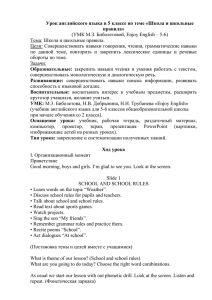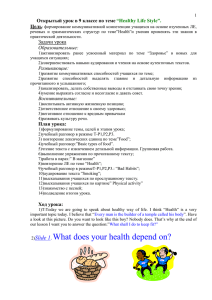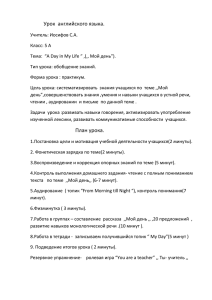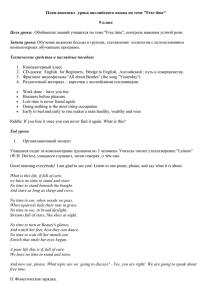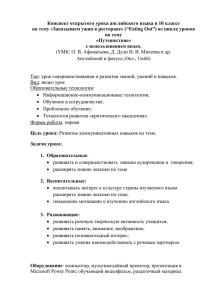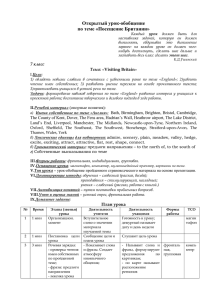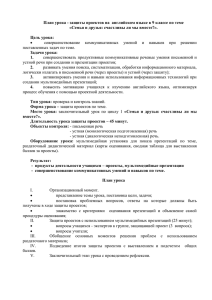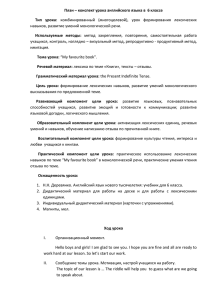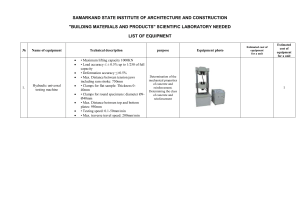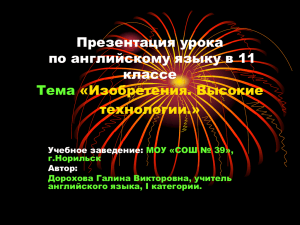План-конспект урока английского языка по теме «Строительные
реклама
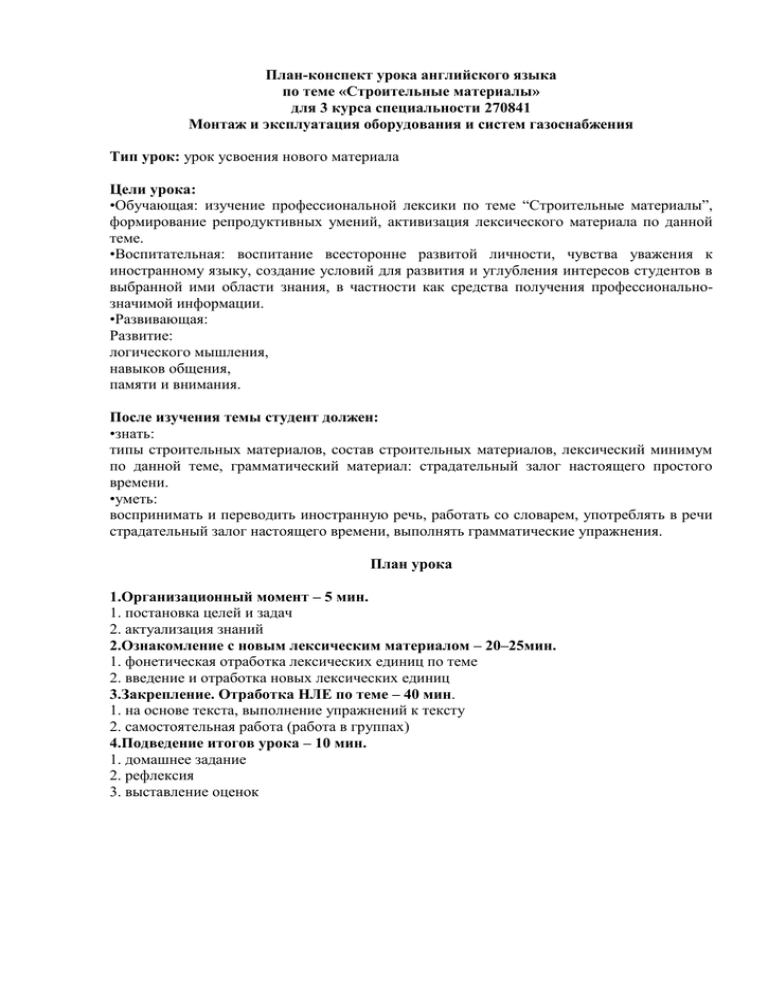
План-конспект урока английского языка по теме «Строительные материалы» для 3 курса специальности 270841 Монтаж и эксплуатация оборудования и систем газоснабжения Тип урок: урок усвоения нового материала Цели урока: •Обучающая: изучение профессиональной лексики по теме “Строительные материалы”, формирование репродуктивных умений, активизация лексического материала по данной теме. •Воспитательная: воспитание всесторонне развитой личности, чувства уважения к иностранному языку, создание условий для развития и углубления интересов студентов в выбранной ими области знания, в частности как средства получения профессиональнозначимой информации. •Развивающая: Развитие: логического мышления, навыков общения, памяти и внимания. После изучения темы студент должен: •знать: типы строительных материалов, состав строительных материалов, лексический минимум по данной теме, грамматический материал: страдательный залог настоящего простого времени. •уметь: воспринимать и переводить иностранную речь, работать со словарем, употреблять в речи страдательный залог настоящего времени, выполнять грамматические упражнения. План урока 1.Организационный момент – 5 мин. 1. постановка целей и задач 2. актуализация знаний 2.Ознакомление с новым лексическим материалом – 20–25мин. 1. фонетическая отработка лексических единиц по теме 2. введение и отработка новых лексических единиц 3.Закрепление. Отработка НЛЕ по теме – 40 мин. 1. на основе текста, выполнение упражнений к тексту 2. самостоятельная работа (работа в группах) 4.Подведение итогов урока – 10 мин. 1. домашнее задание 2. рефлексия 3. выставление оценок Ход урока 1. Приветствие и вступительное слово преподавателя (Greeting): объявление темы, цели, плана занятия. Hello, dear students. I hope you are all fine, aren’t you? So tell me please, who is absent today? Are you ready to work? Haven’t you forgotten your exercise – books at home? Today we shall do some interesting work that refers to building industry. 2. Warm-up activity (языковая разминка): So, students, look at the blackboard, please. Here you can find some words and transcription. Your task is to go to the blackboard and find transcription for each word. And then try to translate this word. (Соедините слово с его транскрипцией): quebracho timber concrete steel lime stone brick sand fine sand masonry mortar plaster ['mo:tə] ['meisnri] [sænd] [brik] [fain' sænd] [sti:I] ['konkri:t] ['timbə] [laim] [p'la:stə] [stoun] [kə'brat∫əu] Tell me please, what is your profession? (Скажите, кто вы по профессии) Do you work with building materials? (вы работаете со строительными материалами?) Do you like it? (Нравится?) Can you lay a brick? (Вы умеете класть кирпич?) Did you built anything? (Что-нибудь строили?) In order to build a house or road, you should know what building materials exist, so we must learn types of building materials (Для того чтобы простроить дом иль дорогу, вам следует знать какие строительные материалы существуют). So, could you tell me the topic of our lesson? (Вы догадались, какая тема урока сегодня?) Yes, you are right. (Правильно) Let’s open your ex-books and write down the date and the topic of the lesson (открываем тетради и записываем число). Very good. What building materials do you know in Russian? (какие строительные материалы вы знаете на русском?). But what is for English “кирпич” and so on. Look at the cards. I suggest you to play a game. Let’s read words try to mach English and Russian words. (Посмотрите на карточки. Я вам предлагаю игру. Подберите русские эквиваленты к английским) timber concrete steel lime stone brick sand finesand toadapt tobind masonry mortar plaster quebracho кирпич связывать песок, гравий мелкозернистый песок штукатурка известковый раствор применять кирпичная вкладка сталь бетон древесина квебрахо известь лесоматериал камень I give you five minutes (я вам даю 5 минут). Let’s check (Проверяем). Name one by one (называем по очереди). If it is wrong, correct it (если не правильно, то исправляем). 3. Go on our work with the words (продолжаем работу с лексикой). Look at these lists (Посмотрите на тексты). Let’s read this text sentence by sentence, try to translate (Читаем по очереди каждое предложение и переводим). Some questions are there for you (и после текста будем выполнять задания) (см. Приложение 1.) I. Read and translate the following sentences and find the passive voice (Прочитайте и переведите следующие предложения, найдите в тексте случаи употребления страдательного залога): Timber, concrete, steel, lime, gypsum, cement are used in the building construction. The building brick is made of clay containing a considerable proportion of fine sand. The most important building materials may now be considered to be structural steel and concrete II. Pick out from the text all the words denoting building materials; give their translations into Russian (выберите из текста все слова, которые относятся к строительным материалам). III. Answer the questions (Ответьте на вопросы): 1. What materials are used in building construction? 2. What materials form very important elements in masonry structures? 3. What is the most accurate method of measuring proportions? IV. Let’s make groups and prepare for the information using this text (Давайте разделимся на группы и каждая группа готовит сообщение, пользуясь текстом): Important building materials. 2. Brick. 3. Timber. 4. Lime. Summarizing (подведение итогов). Shortly, what did we study today? What was new for you, St1, St2… Look at the board again(Взгляните на доску). One person from each group goes to the blackboard and writes what it is (один студент из группы выходит к доске и пишет название строительного материала). Guess, please, what it is? (Отгадайте, что это) (см. Приложение 2.) Home task (Домашнее задание): To learn these words by heart. Thank you for your work at lesson. Your work today was rather good. But some of you were very active. I give you “a five”. Other students have made a lot of progress. I put them “a four”. You need some more practice with… Introspection (рефлексия): To find out students attitude to work at the lesson. Did you like the way we have worked today? Any comments? Have you questions? Good-bye. Приложение 1 THE MOST IMPORTANT AND WIDELY USED BUILDING MATERIALS The civil engineer must be able to select and adapt such materials of construction that will give the most effective result by the most economical means. Timber, steel and concrete all vary, sometimes over considerable ranges in the properties desired by the engineer. Lime, gypsum and cement are the three materials most widely used in building construction for the purpose of binding together masonry units, such as stone, brick and as constituents of wall plaster. Cement is the most important component of concrete. These materials form very important elements in all masonry structures. The most important building materials may now be considered to be structural steel and concrete. Concrete may be considered an artificial conglomerate of crushed stone, gravel or similar inert material with a mortar. A mixture of sand, screenings or similar inert particles with cement and water, which has the capacity of hardening into rocklike mass is called mortar. The fundamental object in proportioning concrete or mortar mixes is the production of a durable material of requisite strength, watertigntness and other essential properties at minimum cost. The most accurate method of measuring proportions is to weigh the required quantities of each material. Lime.whether used for plastering or with brick and stone, is indispensable in building. Lime manufacture is an important industry. The lime of commerce is made from limestone, fragments of marble. Timber. Wood varies greatly in hardness, and some otherwise desirable timbers may be almost too hard to work, e. g. quebracho. Wood can usually be split along the fibres but must be cut across them. An important branch of the timber industry consists in preserving wood from putrefaction. Brick. Common building brick is made of clay containing a considerable proportion of fine sand. The material is kneaded with water, and the mass is pressed through a rectangular opening and cut crosswise with wires. The presence of the sand lowers the plasticity of the raw material, but decreases its tendency to crack, twist, of shrink during drying. The fully dried material is heated until it begins to vitrify. This means that temperature is finally reached at which the more fusible components of the mixture begin to melt to a liquid, which flows around the unfused particles, cementing them firmly together. When it has been carried the ceramic material is said to be completely vitrified. Приложение 2 1. 2. 4. c c 5. 6. 7. 8. 3.
